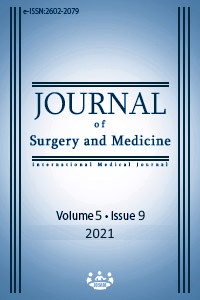Our experience of treating children with primary monosymptomatic enuresis nocturna in a pediatric bedwetting clinic
Keywords:
Enuresis, Bedwetting clinic, Children, TreatmentAbstract
Background/Aim: Enuresis nocturna is an important problem that negatively affects the self-confidence and quality of life of millions of children. Controversial points still exist regarding the treatment algorithm of enuresis. This study aimed to discuss the approach to this condition which deeply affects the child and their family and contribute to the literature by analyzing the success in the treatment steps. Methods: This study was conducted by reviewing the files of the patients who presented to the pediatric bedwetting outpatient clinic between May 2017 and March 2019 with the complaint of nocturia. The diagnoses and treatment outcomes were recorded from the patient files. The first step was motivation therapy, the second step was alarm treatment, and the third step was drug therapy, which were combined if necessary. Results: Among 95 primary monosymptomatic enuresis nocturna patients with a mean age of 8.5 years, all patients received supportive treatment to increase motivation as the first step. The second step consisted of alarm treatment administered to 32 patients and as the third step, medical drug treatment was prescribed to eight. Enuresis decreased in 58% of the patients receiving motivation therapy, 63% of the patients receiving alarm therapy and >90% of the patients receiving drug therapy; however, it relapsed when the medication was discontinued. Conclusion: According to the experience acquired in this study, a specific enuresis polyclinic is important in terms of ease of presentation for patients, and motivation treatment should be the first line of treatment. Other treatment steps can be added as necessary. All three steps in primary monosymptomatic enuresis nocturna can be combined or administered alone.
Downloads
References
American Psychiatric Association. Diagnostic and statistical manual of mental disorders, 5th ed., (DSM-5). Washington, DC: American Psychiatric Publishing; 2013.
Neveus T, von Gontard A, Hoebeke P, Hjälmås K, Bauer S, Bower W, et al. The standardization of terminology of lower urinary tract function in children and adolescents: report from the Standardisation Committee of the International Children’s Continence Society. J Urol. 2006;176(1):314–24. doi: 10.1016/S0022-5347(06)00305-3.
Önen A, Günşar C, Alkan M, Karaman A. Çocuk Ürolojisi. In: Avlan D, eds. Enurezis. İzmir, US akademi, 2021, pp:221-230.
Walker RA. Nocturnal Enuresis, Prim Care Clin Office Pract. 2019;46:243–8.
Haque M, Ellerstein NS, Grundy JH, Shelov SP, Weiss JC, McIntire MS, et al. Parental perceptions of enuresis: A collaborative study. Am J Dis Child. 1981;135:809-11.
Oğraş MS, Ağlamış E, Yücel MÖ, Taşdemir C, Selçuk EB. Treatment and follow up results of patients with monosymptomatic enuresis nocturna. Dicle Med J. 2013;40(3):410-3.
Vande Walle J, Rittig S, Bauer S, Eggert P, Marschall -Kehrel D, Tekdul S, et al, Practical consensus guidelines for the management of enuresis. Eur J Pediatr. 2012;171:971–83. doi: 10.1007/s00431-012-1687-7.
Neveus T, Eggert P, Evans J, Macedo A, Rittig S, Tekgul S, et al. Evaluation of and treatment for monosymptomatic enuresis: a standardization document from the International Children’s Incontinence Society. J Urol. 2010;183:441. doi: 10.1016/j.juro.2009.10.043.
Robson WL, Leung AK. Secondary Nocturnal Enuresis. Clin Pediatr (Phila). 2000;39:379. doi: 10.1177/000992280003900701.
Kovacevic L, Wolfe-Christensen C, Mirkovic J, Yih J, Lakshmanan Y. Renal bladder ultrasound evaluation in monosymptomatic primary nocturnal enuresis: is it really necessary? Pediatr Nephrol. 2014;29(7):1189-94. doi 10.1007/s00467-013-2742-y.
Glazener CMA, Evans JHC,Peto RE. Alarm interventions for nocturnal enuresis in children. Cochrane Database Syst Rev. 2005,2:CD002911. doi: 10.1002/14651858.CD002911.pub2.
Taneli C, Ertan P, Taneli F, Genc A, Günsar C, Sencan A, et al. Effect of alarm treatment on bladder storagec capacities in monosymtomatic nocturnal enuresis. Scand J Urol Nephrol. 2004;38:(3):207-10. doi: 10.1080/00365590310022653.
Austi PF, Ferguson G, Yan Y, Campigotto MJ, E Royer M, E Coplen D. Combination therapy with desmopressin and an anticholinegic medication for nonresponders to desmopressinfor monosymptomatic nocturnal enuresis: a randomized, double-blind, placebo-controlled trial. Pediatrics. 2008;122:1027-32. doi: 10.1542/peds.2007-3691.
Downloads
- 438 467
Published
Issue
Section
How to Cite
License
Copyright (c) 2021 Ali Erdal Karakaya
This work is licensed under a Creative Commons Attribution-NonCommercial-NoDerivatives 4.0 International License.
















